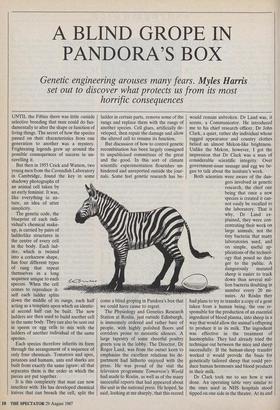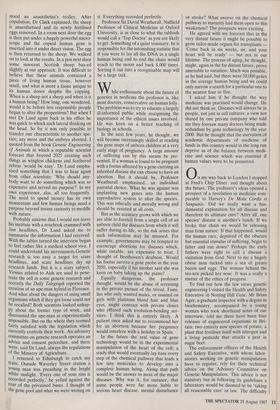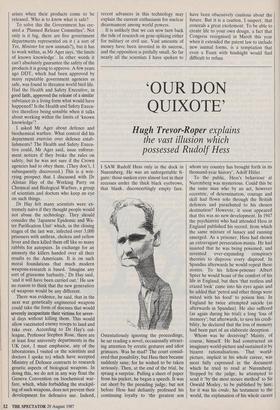A BLIND GROPE IN PANDORA'S BOX
Genetic engineering arouses many fears. Myles Harris
set out to discover what protects us from its most horrific consequences
UNTIL the Fifties there was little outside selective breeding that man could do fun- damentally to alter the shape or function of living things. The secret of how the species passed on their characteristics from one generation to another was a mystery. Frightening legends grew up around the possible consequences of success in un- ravelling it.
Each species therefore inherits its form through the arrangement of a sequence of only four chemicals. Tomatoes and apes, potatoes and humans, ants and sharks are built from exactly the same jigsaw; all that separates them is the order in which the pieces are put together.
It is this complexity that man can now interfere with. He has developed chemical knives that can breach the cell, split the ladder in certain parts, remove some of the rungs and replace them with the rungs of another species. Cell glues, artificially de- veloped, then repair the damage and allow the altered cell to resume its function.
But discussion of how to control genetic recombination has been largely consigned to unpublicised committees of the great and the - good. In this sort of climate scientific experimentation flourishes un- hindered and unreported outside the jour- nals. Some feel genetic research has be- come a blind groping in Pandora's box that we could have cause to regret.
The Physiology and Genetics Research Station at Roslin, just outside Edinburgh, is immensely ordered and rather bare of people, with highly polished floors and corridors prone to monastic silences. A large tapestry of some cheerful poultry greets you in the lobby. The Director, Dr Roger Land, was from the outset keen to emphasise the excellent relations his de- partment had hitherto enjoyed with the press. He was proud of the visit the television programme Tomorrow's World had made to Roslin, as well as of the many successful reports that had appeared about the unit in the national press. He hoped, he said, looking at me sharply, that this record would remain unbroken. Dr Land was, it seems, a Communicator. He introduced me to his chief research officer, Dr John Clark, a quiet, rather shy individual whose rugged appearance and country clothes belied an almost Mekon-like brightness. Unlike the Mekon, however, I got the impression that Dr Clark was a man of considerable scientific integrity. Over government-issue sausage and egg we be- gan to talk about the institute's work.
Both scientists were aware of the dan- gers involved in genetic research, the chief one being that once a new species is created it can- not easily be recalled to the laboratory. That is why, Dr Land ex- plained, they were con- centrating their work on large animals, not the tiny bacteria that many laboratories used, and on simple, useful ap- plications of the technol- ogy that posed no dan- ger to the public. A dangerously mutated sheep is easier to track down than several mil- lion bacteria doubling in number every 20 mi- nutes. At Roslin they had plans to try to transfer a copy of a gene taken from a human being, the one re- sponsible for the production of an essential ingredient of blood plasma, into sheep in a way that would allow the animal's offspring to produce it in its milk. The ingredient was effective in the treatment of haemophilia. They had already tried the technique out between the mice and sheep successfully. If the human-sheep transfer worked it would provide the basis for genetically tailored sheep that could pro- duce human hormones and blood products in their milk.
Dr Clark took me to see how it was done. An operating table very similar to the ones used in NHS hospitals stood tipped on one side in the theatre. At its end stood an anaesthetist's trolley. After copulation, Dr Clark explained, the sheep is anaesthetised and its newly fertilised eggs removed. In a room next door the egg is then put under a hugely powerful micro- scope and the copied human gene is inserted into it under direct vision. The egg is then returned to the sheep. We walked on to look at the results. In a pen next door some innocent Scottish sheep baa-ed slightly at our approach. It was difficult to believe that these animals contained a piece of living human tissue, however small, and what is more a tissue unique to its human donor despite the copying. When is a sheep not a sheep and when is it a human being? How long, one wondered, would it be before less responsible people began to alter the proportions? But when I met Dr Land again back in his office he was quick to whack such lateral thinking on the head. So far it was only possible to transfer one characteristic to another spe- cies; any more and the embryo aborted. I quoted from the book Genetic Engineering of Animals in which a reputable scientist forecast that beyond 2025 creating such things as wingless chickens and feathered zebras 'would be easy'. Dr Land empha- sised something that I was to hear again from other scientists: 'Why should any- body want to do something which was so expensive and served no purpose?' In my own experience, alas, all too frequently. The need to spend money has its own momentum and few human beings need a purpose beyond insane curiosity to meddle with nature.
Probably anxious that I would not leave his institute with a notebook crammed with Sun headlines, Dr Land asked me to summarise the information I had received. With the tables turned the interview began to feel rather like a medical school viva. I could understand his nervousness.Genetic research is too easy a target for scare headlines, and scare headlines dry up research funds. But it is a scary subject. Viruses related to Aids are used to pene- trate the cell in some genetic research and recently the Daily Telegraph reported the creation of an ape-man hybrid in Florence. And what about the dangers of using small organisms which if they got loose could not be recalled? Both scientists looked unhap- py about the former type of work, and discounted the ape-man as experimentally impossible. But on the whole they seemed fairly satisfied with the legislation which currently controls their work. An advisory committee on genetic research operates an advice and consent procedure, and there were, said Dr Land, always the regulations of the Ministry of Agriculture. I returned to Edinburgh to catch my train. Outside Waverley Street station a young man was preaching in the bright white sunlight. 'Every one of your sins is recorded perfectly,' he yelled against the roar of the privatised buses. I thought of the gene pool and what we were writing on it. Everything recorded perfectly.
Professor Sir David Weatherall, Nuffield Professor of Clinical Medicine at Oxford University, is as close to what the tabloids would call a 'Top Doctor' as you are likely to get. Something of a quiet visionary, he is responsible for the astonishing statistic that if you were to lay all the DNA in a single human being end to end the chain would reach to the moon and back 8,000 times. Sorting it out into a recognisable map will be a large task.
While enthusiastic about the future of genetics in medicine the professor is, like most doctors, conservative on human folly. The problem was to try to educate a largely ill-informed public while recognising the importance of the ethical issues involved. He was keen on a better teaching of biology in schools.
In the next few years, he thought, we will become increasingly skilled at reading the gene maps of unborn children at a very early stage of pregnancy. A large amount of suffering can by this means be pre- vented. If a woman is found to be pregnant with a foetus affected by a gene carrying an inherited disease she can choose to have an abortion. But it should be, Professor Weatherall emphasised, an individual parental choice. What he was against was implanting new genes into the human reproductive system to alter the species. This was ethically and morally wrong and should be resisted at all costs.
But as the accuracy grows with which we are able to foretell from a single cell of an unborn child the diseases from which it will suffer during its life, so the risk arises that such information may be misused. For example, governments may be tempted to encourage abortions for diseases which, while curable, are expensive to treat. I thought of Beethoven's deafness. Would his foetus survive a gene probe in the year 2050, especially if his mother said she was keen on baby taking up the piano? Equally dangerous, the professor thought, would be the abuse of screening in the private pursuit of the trivial. Fami- lies who only wanted males, or insisted on girls with platinum blond hair and blue eyes, might contract with private clinics who offered such evolution-bending ser- vices. I think this is entirely likely. A patient once asked me to recommend her for an abortion because her pregnancy would interfere with a holiday in Spain.
In the future the real value of gene technology would be in the experimental manipulation of the heart of the cell; a study that would eventually lay bare every step of the chemical pathway that leads a few tiny molecules to develop into a complete human being. Along that path would be the answer to most of the major diseases. Why was it, for instance, that some people were far more liable to serious heart disease, mental disturbance or stroke? What swerve on the chemical pathway to maturity laid them open to this weakeness? The prospects were exciting.
He agreed with my forecast that in the very distant future it might be possible to grow tailor-made organs for transplants 'Come back in six weeks, sir, and your heart will be ready' — but not in our lifetime. The process of aging, he thought, might, again in the far distant future, prove amenable to variation. Much was possible, as he had said, but there were 50,000 genes in the average human being and we could only narrow a search for a particular one to the nearest four or five.
I asked him if he thought the way medicine was practised would change. He did not think so. Diseases will always be in people, not just in cell cultures: a view not shared by one private company who told me they foresaw many doctors being made redundant by gene technology by the year 2000. But he thought that the starvation of academic departments of medicine of funds in this country would in the long run deprive us of the balance between medi- cine and science which was essential if human values were to be preserved.
0 n my way back to London I stopped at Fred's Chip Diner and thought about the future. The professor's ideas opened a prospect of a revolution in medicine com- parable to Harvey's De Motu Cordis et Sanguinis. Did we really want a fun- damental explanation for all disease and therefore its ultimate cure? After all, one species' disease is another's lunch. If we broke that chain we would be releasing man from nature. If that happened, would the human race, deprived of the obscure but essential stimulus of suffering, begin to falter and run down? Perhaps the early fathers were right to call a disease a visitation from God. Next to me a hugely obese man tucked into a sea of greasy bacon and eggs. The woman behind the tea-urn picked her nose. It was a really a matter of the ethics of progress.
To find out how the law views genetic engineering I visited the Health and Safety Executive in Notting Hill Gate. Mr Brian Ager, a graduate inspector with a degree in biochemistry, accompanied by a young woman who took shorthand notes of our interview, told me there have been four releases of engineered organisms in Bri- tain: two entirely new species of potato, a plant that fertilises itself with nitrogen and a living pesticide that attacks a pest in sugar beet. The enforcement officers of the Health and Safety Executive, with whom labor- atories working on genetic manipulation have to register, rely for their technical advice on the Advisory Committee on Genetic Manipulation. This advice is not statutory but in following its guidelines a laboratory would be deemed to be 'taking all reasonable care' in law. The difficulty arises when their products come to be released. Who is to know what is safe?
To solve this the Government has cre- ated a 'Planned Release Committee'. Not only is it big, there are five government departments represented on it ( a sort of Yes, Minister for new animals?), but it has to work within, as Mr Ager says, 'the limits of known knowledge'. In other words it can't absolutely guarantee the safety of the products it is going to approve. A few years ago DDT, which had been approved by many reputable government agencies as safe, was found to threaten world bird life. Had the Health and Safety Executive, in good faith, approved the release of a similar substance in a living form what would have happened? Is the Health and Safety Execu- tive therefore being sensible when it talks about working within the limits of 'known knowledge'?
I asked Mr Ager about defence and biochemical warfare. What control did his department exercise over defence estab- lishments? The Health and Safety Execu- tive could, Mr Ager said, issue enforce- ment notices if they broke the rules on safety, but he was not sure if the Crown agencies had to obey them. (They don't, I subsequently discovered.) This is a wor- rying prospect that I discussed with Dr Alistair Hay of the Working Party on Chemical and Biological Warfare, a group of scientists and doctors who keep an eye on such things.
Dr Hay felt many scientists were ex- tremely naïve if they thought people would not abuse the technology. They should consider the 'Japanese Epidemic and Wa- ter Purification Unit' which, in the closing stages of the last war, infected over 3,000 prisoners with anthrax, cholera and yellow fever and then killed them off like so many rabbits for autopsies. In exchange for an amnesty the killers handed over all their results to the Americans. It is on such moral foundations that much modern weapons-research is based. 'Imagine any sort of gruesome barbarity,' Dr Hay said, `and it will have been carried out.' He saw no reason to think that the new generation of weapons would be any different.
There was evidence, he said, that in the next war genetically engineered weapons could take the form of diseases that would severely incapacitate their victims for sever- al days without killing them. This would allow vaccinated enemy troops to land and take over. According to Dr Hay's col- league, Professor Stephen Rose, there are at least four university departments in the UK (not, I must emphasise, any of the laboratories I visited or the scientists and doctors I spoke to) which have accepted Ministry of Defence contracts to research genetic aspects of biological weapons. In doing this, we do not in any way flout the Geneva Convention on. biochemical war- fare, which, while forbidding the stockpil- ing of such weapons, does not prevent their development for defensive use. Indeed, recent advances in this technology may explain the current enthusiasm for nuclear disarmament among world powers.
It is unlikely that we can now turn back the tide of research on gene-splicing either for military or civil use. Vast amounts of money have been invested in its success, and the opposition is pitifully small. So far nearly all the scientists I have spoken to have been obsessively cautious about the future. But it is a caution, I suspect, that conceals a great excitement. To be able to create life to your own design, a fact that Congress recognised in March this year when it extended the patent law to include new animal forms, is a temptation that even a Faust with hindsight would find difficult to refuse.












































 Previous page
Previous page